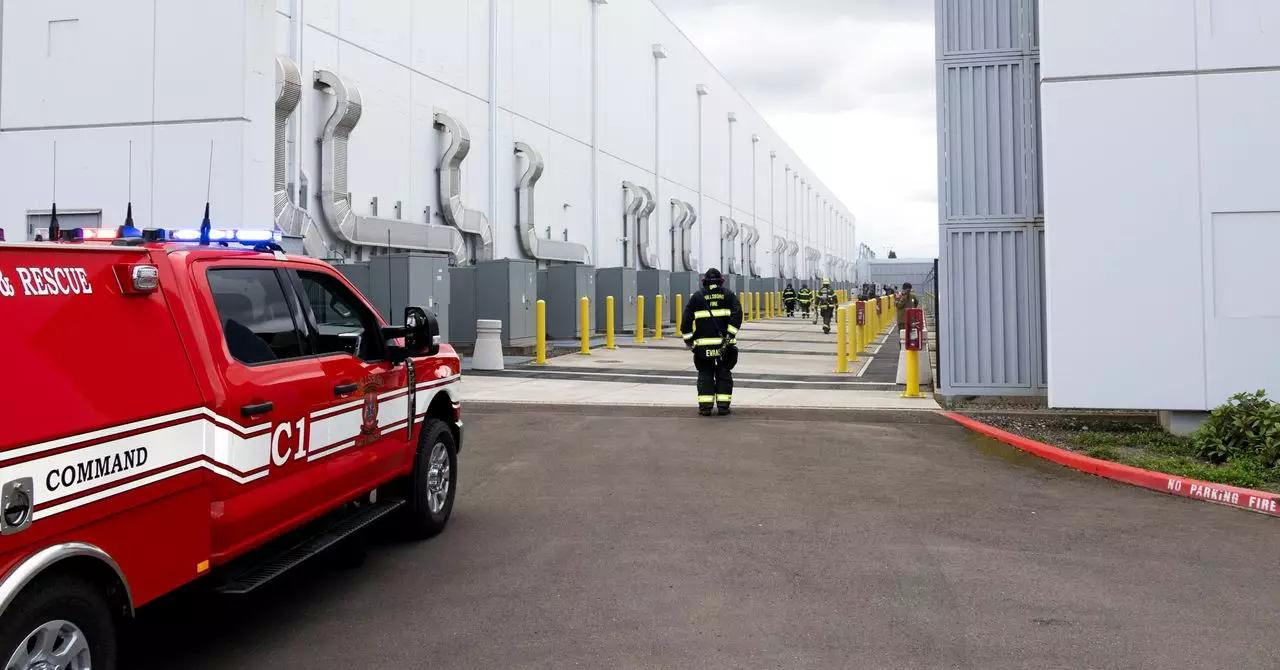In an era where digital connectivity defines our daily lives, the backbone of this digital age—the data center—remains largely unseen and underestimated in its vulnerabilities. The recent blaze in a data center operated by Digital Realty, which houses servers for Elon Musk’s X platform, sheds harsh light on the precariousness of these technological fortresses. While on the surface, data centers appear as highly secure, meticulously engineered environments, they are fraught with latent hazards that, if left unaddressed, could jeopardize entire digital ecosystems.
The Hillsboro incident underscores a potent truth: our reliance on complex electrical and mechanical systems inherently introduces risk. Electrical malfunctions, especially within uninterruptible power supply (UPS) units—which act as critical safeguards during power irregularities—pose a significant threat. The fire, initially suspected to involve lithium-ion batteries (a common component in energy backup systems), ultimately caused by an electrical fault, highlights how even well-designed systems can fail catastrophically. This event is not merely an isolated anomaly; it exemplifies the vulnerabilities that are escalating as AI and cloud computing demand more power and larger infrastructure footprints.
The Hidden Cost of Technological Progress
The push for more advanced AI technologies has exponentially increased the energy demands of data centers. To meet these towering needs, facilities are expanding, and systems that regulate power and temperature are working overtime. This relentless growth often outpaces the capacity of existing safety measures, creating a ‘perfect storm’ of potential failures. High loads, combined with insufficient cooling or monitoring, can lead to overheating—an often overlooked precursor to fires.
In the case of the Hillsboro fire, the evidence suggests that the UPS cabinet’s malfunction was the crux of the disaster. The cabinet’s interior, likely compromised by electrical failure, ignited the blaze. The fire’s origin inside the UPS unit indicates that protective measures may have been under a significant strain, revealing a disturbing vulnerability in system design and maintenance. Industry experts like Shaolei Ren emphasize that the susceptibility of large battery packs to failure—paralleling electric vehicle batteries—must be seriously reconsidered in the context of data center safety.
This incident is emblematic of a broader issue: our infrastructure’s rapid expansion, driven by the insatiable appetite for AI, is outpacing safety protocols. Companies are racing to upgrade capacity without adequately addressing the root causes of electrical failures, leaving critical systems like UPS units exposed to hazards they were not originally designed to withstand.
The Overlooked Dangers of Oversight and Maintenance
One of the most unsettling aspects of the Hillsboro fire lies in its ambiguous ignition cause. Fire investigators couldn’t definitively pinpoint the failure’s origin, merely suggesting an internal electrical or mechanical fault within the UPS. Such uncertainty points to a troubling gap in ongoing monitoring and maintenance practices.
Electrical systems, especially complex ones like in data centers, require meticulous oversight. Shaolei Ren points out that inadequate cooling, temperature fluctuations, and insufficient inspection routines are common factors that precipitate fires. These systemic flaws underscore a critical failure of rigorous safety standards. Data center operators often focus on uptime and operational metrics, sometimes at the expense of preventative maintenance, which could catch early signs of electrical malfunction before they turn into destructive fires.
Furthermore, the incident reveals the importance of transparent reporting and proactive safety measures. Digital Realty’s attempt to downplay the fire’s cause by emphasizing that it was not lithium-ion battery-related could be perceived as an effort to avoid accountability or public concern. However, such reassurances do little to address the core issues—namely, whether the safety systems are robust enough to prevent future failures.
The Costly Consequences of Complacency
Financial losses from data center fires are significant, with the Hillsboro incident causing an estimated $260,000 in damages. While this figure may seem modest compared to the sprawling financial scale of tech giants, it embodies a broader issue: the cost of neglecting systemic vulnerabilities. The destruction not only affects the operational integrity of the data center but also risks data integrity, customer trust, and the reputation of the organizations involved.
The fire also exposes a critical need for technological innovation in infrastructure safety. Relying solely on traditional fire suppression and standard electrical safeguards may no longer suffice in the face of rapidly evolving risks. Integrating smarter monitoring systems, enhancing system redundancies, and adopting innovative cooling and safety protocols are imperative to safeguard these vital hubs of digital life.
Moreover, as AI continues to expand and data needs grow exponentially, the environmental footprint of these facilities will intensify. This perpetuates a dangerous cycle: increased power consumption leads to greater risks, which, if realized, could cause widespread disruptions far beyond the immediate physical damage.
Reflection and Responsibility in the Age of Digital Dependency
The Hillsboro incident serves as a wake-up call for industry leaders, policymakers, and technologists alike. We must confront the uncomfortable truth that the infrastructure supporting our digital world is not infallible. The complacency that once surrounded data center safety must give way to rigorous, proactive strategies designed to preempt disaster.
In this pursuit, transparency and accountability are paramount. Companies must prioritize comprehensive safety audits, invest in smarter systems, and foster a culture that treats electrical and mechanical integrity as a core responsibility—not an afterthought. As the world’s reliance on AI and cloud computing accelerates, so too must our commitment to ensuring that these technological marvels are as safe as they are revolutionary.
In the end, the fires that threaten our data centers are a stark reminder that even the most advanced systems are susceptible to failure. Recognizing and addressing these vulnerabilities today is essential to avoid catastrophic consequences tomorrow. The future of our interconnected world depends on it.


Leave a Reply